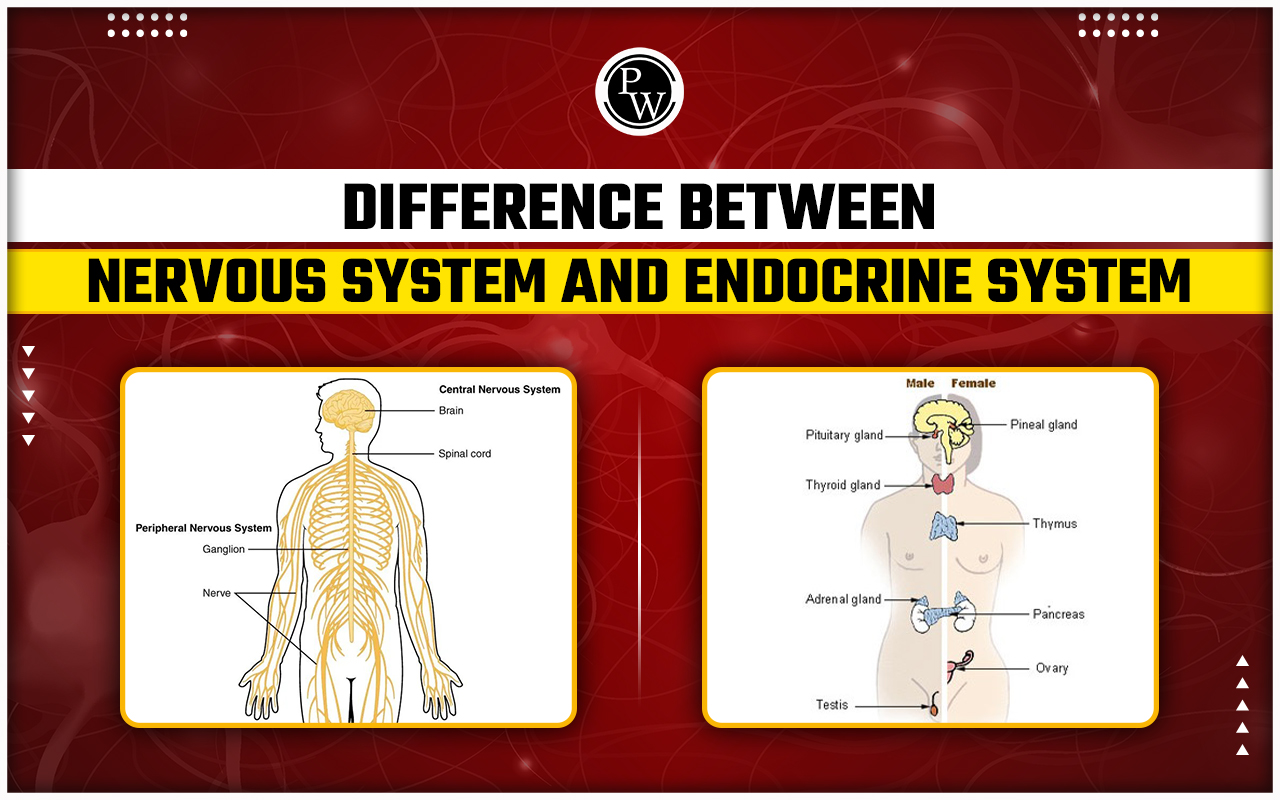

Difference Between Nervous System and Endocrine System: The nervous system uses electrical impulses to collect, process, and respond to environmental information, and neurons' unique structure allows them to be transmitted throughout the body more easily. Glial cells support neurons by shielding, surrounding, and insulating them.
Similarly, the endocrine system acts as a regulatory mechanism, using chemical messages known as hormones rather than electrical impulses to keep cells and organs functioning properly. Unlike the nervous system, which relies on electrical impulses, the endocrine system communicates with specific organs and cells via hormones that travel through the bloodstream. This article discusses the difference between nervous system and endocrine system.
NEET 2024 Information Bulletin Released
NEET UG 2024 Application Form Out
Difference Between Nervous System and Endocrine System Overview
The nervous and endocrine systems manage and coordinate the human body's functions. While the nervous system allows for quick responses to stimuli, the endocrine system controls slower, more lasting changes in the body. In this article, the difference between nervous system and endocrine system is explained.
The nervous system, which includes the brain, spinal cord, and a network of nerves, allows different body parts to communicate. It is made up of two major parts: the central nervous system (CNS), which includes the brain and spinal cord, and the peripheral nervous system (PNS), which includes all nerves outside of the CNS. The PNS is further divided into sensory nerves, which carry information from the body to the brain, and motor nerves, which send signals to muscles and glands.

On the other hand, the endocrine system is a complex network of glands that secrete hormones directly into the bloodstream. These chemical messengers control many bodily functions, including metabolism, growth, and reproduction. The pituitary gland, adrenal gland, thyroid gland, ovaries, pancreas, and testes are all essential parts of the endocrine system. The detailed difference between nervous system and endocrine system are outlined in the article below.
Difference Between Nervous System and Endocrine System
The nervous and endocrine systems play essential roles in regulating various organisms. They enable the body to adapt to its surroundings and safeguard its well-being. Although both systems transmit signals from the brain to target cells, they operate differently. The difference between nervous system and endocrine system is evident. The table below shows a detailed difference between nervous system and endocrine system:
| Difference Between Nervous System and Endocrine System | ||
| Aspect of Differences | Nervous System | Endocrine System |
| Description | It consists of an extensive network of nerves that transmit messages between the spinal cord, brain, and body. | Comprises glands that produce hormones regulating various bodily functions such as growth, metabolism, etc. |
| Transmission | Relies on electrical impulses or pulses transmitted through specialized cells called neurons. | Relies on hormones, which are chemical messengers transported through the bloodstream. |
| Components | Includes the brain and spinal cord. | Includes glands like the thyroid, pituitary, and reproductive organs such as ovaries and testes. |
| Signal Transmission | Facilitated by neurons to transmit nerve impulses. | Relies on blood vessels to transport hormones to target cells. |
| Response Time | Exhibits a rapid response to stimuli through action potentials. | Displays a slower reaction as hormones are released into the bloodstream and act on target tissues. |
| Signal Transmission | Nerve impulses utilize neurotransmitters and ion channels. | Hormones diffuse across the plasma membrane or bind to specific cell receptors. |
| Control | Under both active and involuntary control. | Predominantly under involuntary control. |

Nervous System
Nervous System is a complex network of cells and fibres, that plays an essential role in how our bodies function. It processes information from our surroundings and coordinates responses, all through electrical impulses. Divided into two main parts, the nervous system ensures seamless communication throughout the body:
- Central Nervous System (CNS):
- CNS consists of the brain and spinal cord, the CNS acts as the control center. It receives sensory input, interprets signals, and generates appropriate responses.
- The brain, with its intricate structure, analyzes incoming data and formulates commands. Meanwhile, the spinal cord acts as a conduit, transmitting messages between the brain and peripheral nerves.
- Peripheral Nervous System (PNS):
- The PNS branches out from the CNS, extending throughout the body. It includes the somatic nervous system (SNS) and the autonomic nervous system (ANS).
- The SNS governs voluntary actions and reflexes. It allows for conscious muscle movement and swift reactions to stimuli.
- On the other hand, the ANS regulates involuntary processes, such as heart rate and digestion. It consists of the sympathetic and parasympathetic divisions, ensuring our bodies function smoothly without conscious effort.
NEET Biology Chapter wise Weightage
Endocrine System
The endocrine system is made up of glands that produce hormones that facilitate cellular communication and regulate various bodily functions; dysfunction in this system can interfere with fertility, puberty, and stress management, resulting in weight gain, weakened bones, or fatigue due to blood sugar imbalances.
Glands, or organs that produce and release hormones, are essential to the body's endocrine and exocrine functions. These compounds circulate in the bloodstream, influencing a variety of physiological processes. The endocrine system's key components are:
Hypothalamus: Links the endocrine and neurological systems, directing the pituitary gland's hormone production.
Pituitary gland: Central to the endocrine system, it coordinates other gland functions, producing hormones like prolactin, growth hormone, and thyroid-stimulating hormone.
Thyroid gland: Regulates growth and metabolism; hypoactivity leads to sluggishness, weight gain, while hyperactivity causes rapid pulse, weight loss.
Parathyroid: Four glands behind the thyroid, regulating bone health and calcium-phosphorus levels.
Thymus: Vital for immune system development in children, diminishing post-puberty.
Adrenals: Known for adrenaline production, they also secrete corticosteroids, impacting metabolism and sexual function.
Pancreas: Balances blood sugar levels via insulin and glucagon production, besides aiding digestion with digestive enzymes.
Physics Wallah provides the best NEET online coaching for students. The PW NEET Online Coaching Program offers students the best and most affordable courses. The best faculty for the NEET Exam and the best online NEET courses are available to you Enroll Now!
Difference Between Nervous System and Endocrine System FAQs
What distinguishes the nervous systems?
What role does the nervous system play?
What are the primary organs of the CNS?
Where is the endocrine gland situated?
What is the endocrine system and its function?
How does the endocrine system differ from the nervous system?












